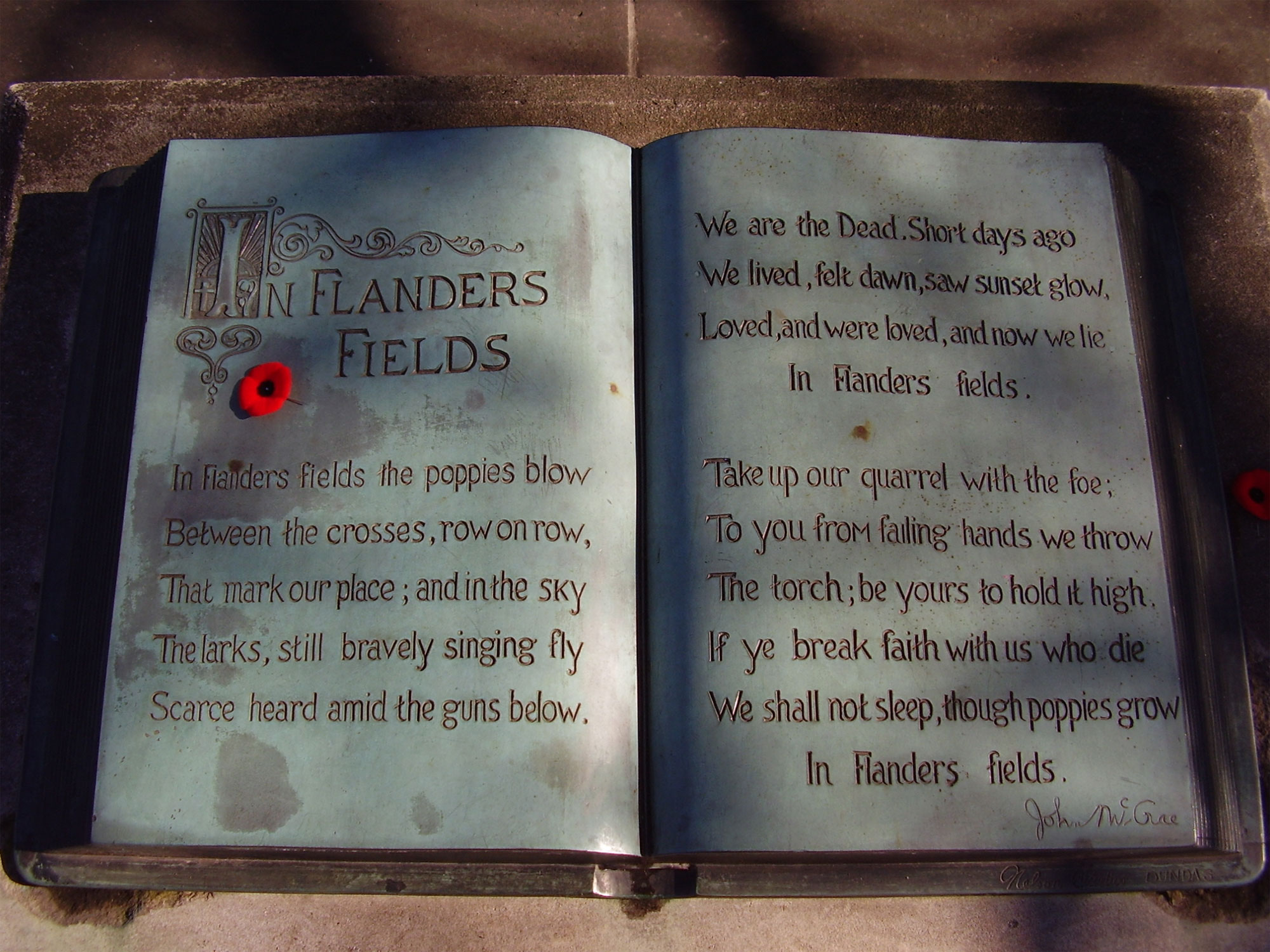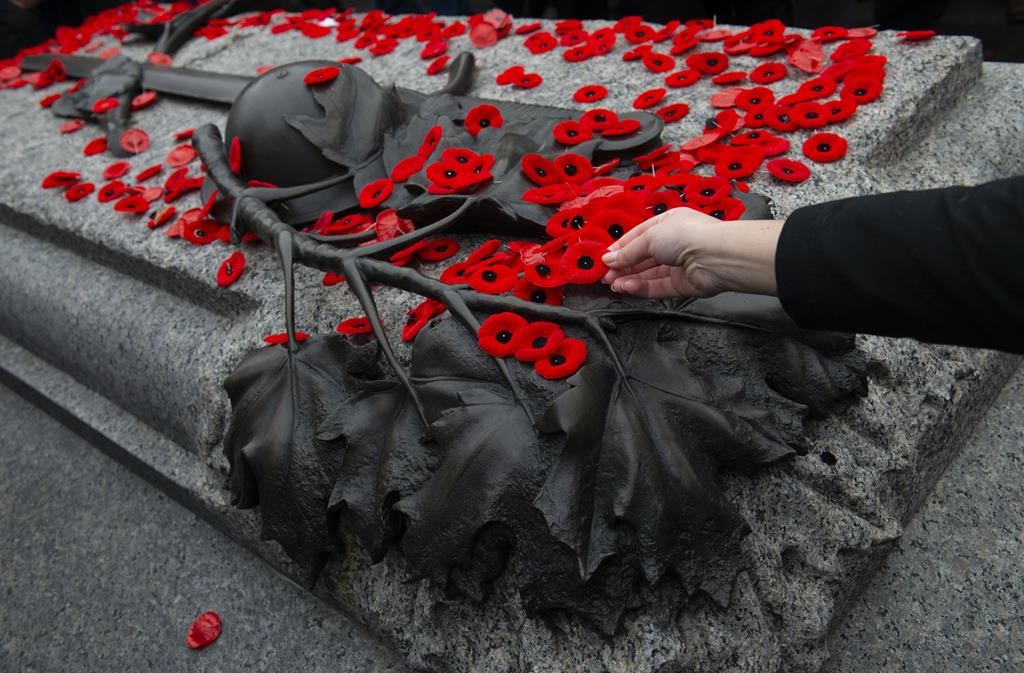100 years: How the poppy came to be the symbol of remembrance in Canada

Posted November 10, 2021 10:10 am.
Last Updated November 11, 2021 7:40 pm.
Starting the last Friday of October through to Remembrance Day, millions of Canadians pin a poppy to their lapels as a sign of respect and to honour the memories of those who sacrificed their lives, or large portions of it, in defence of the country and its freedom.
The small plastic flower is distributed freely by the Royal Canadian Legion, but donations are encouraged in support of veterans and their families.
Connection to war and honouring veterans
As per the Royal Canadian Legion, the connection of the poppy flower to war and honouring veterans dates back to the Napolenic Wars in the 19th century.
Thick poppies reportedly grew over the graves of soldiers in the area of Flanders, France and fields that had been bare before the battles bloomed with red poppies after the fighting ceased. During the war, the soil in the area became rich in lime from the rubble of ammunition and bombs, creating fertile conditions for the poppy flower to thrive. When the war ended, the lime was absorbed into the earth and the poppies began to die out.
“One of the earliest, direct associations [of poppies with veterans] during the First World War actually came from a Canadian, and that of course is Lieutenant-Colonel, John McCrae,” explains Dr. Roger Sarty, professor of history at Wilfrid Laurier University and former deputy director of the Canadian War Museum. “Fairly early in the war in the awful Ypres Salient in Belgium, after a terrible Second Battle of Ypres, he, exhausted, wrote down his reflections in a poem that later became famous, called ‘In Flanders Fields’,” while looking after very heavy casualties.
The Second Battle of Ypres in April, 1915 was the first major battle of the First World War fought by Canadians. More than 6,000 soldiers were killed or wounded — nearly a third of the Canadian Division.
Guelph-born McCrae read the 13-line poem as as part of a eulogy for his friend and fellow soldier Lieutenant Alexis Helmer.
Dr. Sarty adds that the poem was also used in recruitment efforts in many countries as it referenced “the dead, lying beneath the poppies, calling out to the living to carry on the fight.”
Take up our quarrel with the foe:To you from failing hands we throw
The torch; be yours to hold it high.

Inscription of the poem “In Flanders Fields” in a book at the John McCrae memorial in Guelph, Ont., on Nov. 11, 2009. CREATIVE COMMONS/Lx 121
Origins of the poppy as a symbol of remembrance
Credit for the concept of the Remembrance Poppy is ascribed to two revolutionary women who both came to be known as the “poppy lady” — Moina Michael and Madame Anna Guérin.
Moina Michael
Moina Michael was born in the United States and was an educator for most of her career. When the United States entered the First World War in 1917, she took a sabbatical from her career to volunteer with the American Overseas YMCA that trained overseas YMCA workers.
In 1918, she discovered McRae’s poem and penned one of her own called “We Shall Keep the Faith” and decided to wear a silk poppy as a symbol of remembrance for those who served in the war.
When she returned to her work as a professor at the University of Georgia in 1920, she taught a class of disabled servicemen. She later pursued the idea of selling silk poppies as a means to raise funds for them and petitioned the American Legion to have it adopted as a national symbol of remembrance.
Madame Anna Guérin
Madame Anna Guérin was born in France and was a humanitarian and teacher who was also inspired by McCrae’s enduring poem. She immigrated first to Britain and then to the U.S.
Prof. Sarty explains that during the First World War “she became tremendously active in promoting the interests of the many French people who had been dislocated by the war.”
Around 1919, she began holding “poppy days” in the U.S. and distributing paper or fabric poppies in exchange for donations to benefit the widows and orphans left behind in the warn-torn regions of France. She was invited to explain the concept at the 1920 American Legion conference and thereafter, the American Legion adopted the poppy as its memorial flower.
In 1921, she travelled to Canada where she presented the idea to The Great War Veterans Association, the precursor to The Royal Canadian Legion. The group adopted the symbol as well as the idea of “poppy day” and became the first veterans of the British Empire to do so. Thereafter began the mass manufacturing of poppies and the emergence of the Royal Canadian Legion’s yearly poppy campaign.
“Most of what happens today all began in 1921, largely as a result of that very courageous and determined French woman, Anna Guérin,” concludes Prof. Sarty.

A poppy is placed on the Tomb of The Unknown Soldier following a Remembrance Day ceremony at the National War Memorial in Ottawa on Monday Nov. 11, 2019. THE CANADIAN PRESS/Sean Kilpatrick
100 years of the poppy
The Royal Canadian Legion is marking 100 years of the poppy, which has now come to symbolize honouring Canadians fallen or injured in all conflicts since it was first adopted, including both World Wars, Korea, Afghanistan, Bosnia, peacekeeping duties and other military assignments.
The Legion’s National Poppy Campaign begins on the last Friday of October and runs to November 11. Every year, around $20 million is donated and distributed through the campaign. “Funds donated locally are distributed locally. Funds contributed at a national level are distributed nationally,” notes the Legion’s website.
The Legion has the exclusive right to use the poppy as Canada’s symbol of remembrance and while people may create their own poppies for themselves, they cannot be sold for remembrance without permission from the Legion. This is to ensure that any funds raised from the sale of poppies are used to support veterans and their families.
To commemorate 100 years of the poppy, the Legion has released a replica of the original fabric pin distributed during the First World War. They’ve also created a “gallery of remembrance” and are encouraging people to honour the veterans in their lives by submitting photos and memories of them.
A digital poppy was introduced in 2018 and for the 100-year anniversary, limited edition NFTs have been released that feature a 3D replica of a real poppy picked from Flanders Fields.
“118,000 names of fallen Canadian soldiers grace its petals and are linked to the blockchain, with 10 notable fallen featured across the NFTs – immortalizing the memory of those who fought for our freedoms,” explains the Legion’s website.
Click here for locations of poppy campaign partners where you can pick up a poppy and donate.








